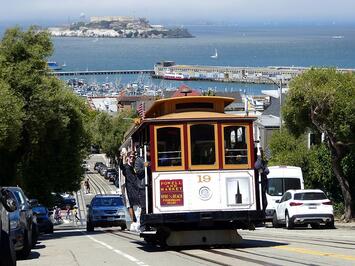
Like many transit agencies, San Francisco Municipal Transportation Agency (Muni) is facing a big budget deficit, and its response is to employ the Washington Monument Strategy. For those who don’t know, back in 1969 President Nixon tried to reduce the National Park Service’s budget and the Park Service responded by shutting down the Washington Monument. Tourists who wanted to ride the elevator to the top of the monument were directed to the senate and house office buildings and told to ask their elected representatives to restore the agency’s budget. Congress restored the funding, but Nixon fired the Park Service director who thought up the strategy a few years later.
We may need to rename this the Cable Car Strategy, as Muni is proposing to reduce its deficit by suspending service on the cable car routes as well as some streetcar routes that are mainly used by tourists. While it’s true that cable car ridership has been slow to recover from the pandemic — as of September, it was less than 69 percent of 2019 numbers — it’s also true that cable cars are the symbol of the city and an important tourist attraction. Considering all the bad publicity San Francisco has received lately, its commercial interests don’t want to do anything to depress tourism still further.
Muni knows this, of course, which is why it is floating cutting the cable cars as a trial balloon. It obviously hopes that local taxpayers will eagerly support tax increases to keep the cable cars climbing halfway to the starts. Unfortunately, taxpayers are pretty defenseless against this strategy, so it will probably work and many other transit agencies are probably using a similar strategy to restore their budgets despite low ridership.
This piece first appeared at The Antiplanner.
Randal O'Toole, the Antiplanner, is a policy analyst with nearly 50 years of experience reviewing transportation and land-use plans and the author of The Best-Laid Plans: How Government Planning Harms Your Quality of Life, Your Pocketbook, and Your Future.
Photo: Pi.1415926535 via via Wikimedia, under CC BY-SA 4.0.












